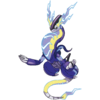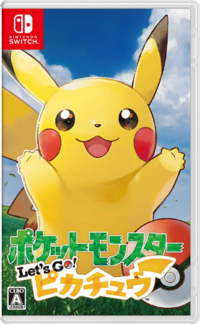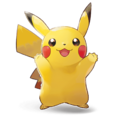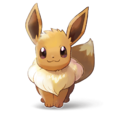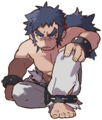Pokémon: Let's Go, Pikachu! and Let's Go, Eevee!: Difference between revisions
Technickal (talk | contribs) (→Trivia: It was in the English versions too.) |
|||
| Line 187: | Line 187: | ||
==Trivia== | ==Trivia== | ||
[[File:Let's Go Pocket Monsters Pikachu.png|thumb|200px|Professor Oak's introduction in Japanese Pokémon Yellow]] | [[File:Let's Go Pocket Monsters Pikachu.png|thumb|200px|Professor Oak's introduction in Japanese Pokémon Yellow]] | ||
* The term "Let's Go!" may be a reference to [[Pokémon GO]] and the end phrase of [[Professor Oak]]'s introduction | * The term "Let's Go!" (Japanese: レッツ ゴー!) may be a reference to [[Pokémon GO]] and the end phrase of [[Professor Oak]]'s introduction in the Japanese and English versions of the [[Generation I]] [[core series]] games. | ||
* These are the first core series games to be released exclusively on a home console. | * These are the first core series games to be released exclusively on a home console. | ||
* These are the only core series games to be playable exclusively on a system different from other core series games in their generation. | * These are the only core series games to be playable exclusively on a system different from other core series games in their generation. | ||
Revision as of 16:35, 13 November 2018
| Pokémon: Let's Go, Pikachu! ポケットモンスター Let's Go! ピカチュウ | |
|---|---|
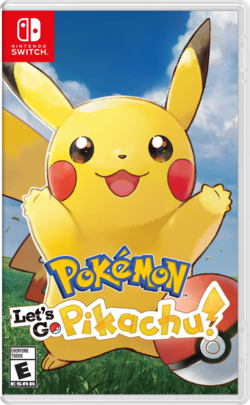 English boxart of Pokémon: Let's Go, Pikachu! | |
| Pokémon: Let's Go, Eevee! ポケットモンスター Let's Go! イーブイ | |
 English boxart of Pokémon: Let's Go, Eevee! | |
Basic info
| |
| Platform: | Nintendo Switch |
| Category: | RPG |
| Players: | 1-2 players |
| Connectivity: | Wireless, Nintendo Switch Online |
| Developer: | Game Freak |
| Publisher: | Nintendo/The Pokémon Company |
| Part of: | Generation VII core series |
Ratings
| |
| CERO: | A |
| ESRB: | E |
| ACB: | PG |
| OFLC: | PG |
| PEGI: | 7 |
| GRAC: | ALL |
| GSRR: | 6+ |
Release dates
| |
| Japan: | November 16, 2018 |
| North America: | November 16, 2018 |
| Australia: | November 16, 2018 |
| Europe: | November 16, 2018 |
| South Korea: | November 16, 2018 |
| Mainland China: | N/A |
| Hong Kong: | November 16, 2018 |
| Taiwan: | November 16, 2018 |
Websites
| |
| Japanese: | Pokémon.co.jp |
| English: | Official site Pokémon.com |
|
Japanese boxart
| |
Pokémon: Let's Go, Pikachu! (Japanese: ポケットモンスター Let's Go! ピカチュウ Pocket Monsters: Let's Go! Pikachu) and Pokémon: Let's Go, Eevee! (Japanese: ポケットモンスター Let's Go! イーブイ Pocket Monsters: Let's Go! Eievui) are the third and final paired versions of Generation VII. The games will be released on the Nintendo Switch.
The games were announced worldwide on May 30, 2018, at a Pokémon press conference in Tokyo, Japan.[1][2] The paired versions will be released worldwide on November 16, 2018. All copies of the game are playable in nine languages: Japanese, English, German, Spanish, French, Italian, Korean, and Simplified and Traditional Chinese.
The games are inspired by Pokémon Yellow.
Plot
The games are set in the region of Kanto, with Pikachu available in Let's Go, Pikachu! and Eevee available in Let's Go, Eevee! as a starter Pokémon. The player will encounter Team Rocket, as well as have the opportunity to meet two all-new Pokémon.
Features
- Pikachu, like in all core series games since Pokémon X and Y, is voiced by Ikue Ohtani, while Eevee is voiced by Aoi Yūki for the first time.[3] In this game, the female starter Eevee will have a unique heart-shaped pattern around the tip of their tail.
- In addition to customizing the player's clothing, the starter Pokémon can also be dressed in different outfits and be given different hair styles.
- An accessory called the Poké Ball Plus can be used to catch Pokémon in place of a Joy-Con. Like the Pokéwalker, a Pokémon can be taken on the go and be interacted with.
- If the player has gathered 25 of the same species of Pokémon in the GO Park, they can play a minigame in the Park's Play Yard for Candy.
- The introduction of two new Mythical Pokémon: Meltan and its evolved form, Melmetal.
- Once the player has become the Champion, Master Trainers will appear and can be found scattered throughout the Kanto region. They are considered the strongest Trainers for each Pokémon species in Generation I and can be spotted by the icon of the Pokémon they favor above their heads.
Alterations from other core series games
- The game focuses on the 151 Pokémon of Generation I. Players can also import the Alolan forms of these Pokémon from Pokémon GO, or receive them from in-game trades.
- Wild Pokémon appear on the overworld. Coming into contact with one will engage them. They may appear with either a red or blue aura, which indicates their size, either being larger or smaller than their own standard size. Similar to the previous games, there is a chance to encounter Shiny Pokémon in the wild.
- The Nintendo Switch Joy-Con is used to catch Pokémon by flicking one's wrist in a throwing motion, similar to the method in Pokémon GO. While in handheld mode, wild Pokémon are caught by moving a reticle with motion controls. Wild Pokémon, except for Legendary Pokémon, can no longer be battled in a traditional sense, but NPC Trainers can be battled as normal.
- Legendary Pokémon can only be caught after defeating them in a battle.
- A unique training system called the Candy Jar will be used for training and increasing the stats of Pokémon by giving them various types of candy, similar to the candy from Pokémon GO.
- Exclusive new moves will be available for the starter Pikachu and Eevee. Pikachu will be able to learn Splishy Splash and Floaty Fall, while Eevee can learn Bouncy Bubble, Buzzy Buzz, Sizzly Slide, Glitzy Glow, and Baddy Bad. These moves can be learned from a Move Tutor in Celadon City's Pokémon Center.
- The starter Pikachu and Eevee can activate partner powers in battle once they have high enough friendship. If activated while they are in battle, they use an exclusive move—Pika Papow or Veevee Volley—which increases in damage based on friendship. If activated while they are not in battle, they boost the stats of the current Pokémon.
- HM moves have been replaced by Secret Techniques that the starter Pikachu and Eevee can use in the overworld, but do not take up move slots. These include Chop Down for Cut, Sea Skim for Surf, and Sky Dash for Fly.
Returning features
- Gym Leaders of Kanto and their Badges, as well as the Elite Four of the Indigo Plateau, return.
- Team Rocket returns, including the trio from the anime series, Jessie, James, and Meowth. Unlike in their game debut Pokémon Yellow, Jessie and James will engage the player in a Double Battle instead and appear early in Viridian City.[4]
- Pokémon that the player has in their party follow them outside their Poké Balls like they did in Pokémon HeartGold and SoulSilver.
- Mega Evolutions that were introduced in Pokémon X and Y, including Mega Venusaur, Mega Charizard X/Mega Charizard Y, Mega Blastoise, Mega Kangaskhan, and Mega Gyarados as well as their corresponding Mega Stones.
Storyline changes from Generations I and III
- The game features entirely new protagonists, and the role of Blue is replaced with a new, friendly rival.
- The player instead meets Red, Blue, and for the first time as a non-player character, Leaf[citation needed], over the course of their adventure.
Pokémon
Game-exclusive Pokémon
|
| ||||||||||||||||||||||||||||||||||||||||||||||||||||||||||||||||||||||||||
Compatibility
The games will be compatible with any number of Pokémon GO accounts through Bluetooth LE. Players can send Generation I Pokémon and their Alola Forms from their phone to the games where they will appear in GO Park. The games can give Pokémon GO accounts various rewards in exchange.
Music
The game's music was arranged and composed by Shota Kageyama.[5]
Demonstration
The demo version of Let's Go, Pikachu! and Let's Go, Eevee! were playable at several events worldwide prior to the games' release.
- In the United States, the demo events were available at Pokémon Let’s Go Road Trip tour from September 29 to November 15, 2018, starting in Los Angeles, San Franciso, Seattle, Dallas, Topeka, and Chicago, and later in Boston and New York.[6]
Gallery
Male player character
- Lets Go Pikachu Eevee Rival.png
- Meltan.png
- Melmetal.png
Trailer
Japanese
| |
| This video is not available on Bulbapedia; instead, you can watch the video on YouTube here. | |
| |
| This video is not available on Bulbapedia; instead, you can watch the video on YouTube here. | |
| |
| This video is not available on Bulbapedia; instead, you can watch the video on YouTube here. | |
| |
| This video is not available on Bulbapedia; instead, you can watch the video on YouTube here. | |
| |
| This video is not available on Bulbapedia; instead, you can watch the video on YouTube here. | |
| |
| This video is not available on Bulbapedia; instead, you can watch the video on YouTube here. | |
English
| |
| This video is not available on Bulbapedia; instead, you can watch the video on YouTube here. | |
| |
| This video is not available on Bulbapedia; instead, you can watch the video on YouTube here. | |
| |
| This video is not available on Bulbapedia; instead, you can watch the video on YouTube here. | |
| |
| This video is not available on Bulbapedia; instead, you can watch the video on YouTube here. | |
| |
| This video is not available on Bulbapedia; instead, you can watch the video on YouTube here. | |
| |
| This video is not available on Bulbapedia; instead, you can watch the video on YouTube here. | |
| |
| This video is not available on Bulbapedia; instead, you can watch the video on YouTube here. | |
| |
| This video is not available on Bulbapedia; instead, you can watch the video on YouTube here. | |
Trivia
- The term "Let's Go!" (Japanese: レッツ ゴー!) may be a reference to Pokémon GO and the end phrase of Professor Oak's introduction in the Japanese and English versions of the Generation I core series games.
- These are the first core series games to be released exclusively on a home console.
- These are the only core series games to be playable exclusively on a system different from other core series games in their generation.
- Let's Go, Pikachu! has the longest name of all core series titles, including symbols and spaces, with 18.
- These mark the first time that an upper version has been remade.
- As revealed in an interview with Junichi Masuda, the reason Eevee was chosen as a game mascot alongside Pikachu was because of all of the fanart Eevee has gotten.[7]
- Masuda also revealed that Psyduck was considered for the role instead of Eevee, but was not chosen because it was the same color as Pikachu.
- These are the first core series games where not every Pokémon revealed at the time is programmed into the games.
- These are the first core series games since Pokémon Ruby and Sapphire to not be compatible with previous core series titles in any way.
In other languages
| |||||||||||||||||||||||||||||
References
- ↑ Huge Pokémon News Revealed in Tokyo | Pokemon.com
- ↑ Pokémon Creators Share More Details on Upcoming Games | Pokemon.com
- ↑ @project_eevee (Twitter)
- ↑ hajime (Youtube)
- ↑ Shota Kageyama's Twitter
- ↑ Pikachu and Eevee embark on a road trip across the U.S. to demo new Pokémon games - Nintendo Official Site
- ↑ [1]

|
This game-related article is part of Project Games, a Bulbapedia project that aims to write comprehensive articles on the Pokémon games. |
